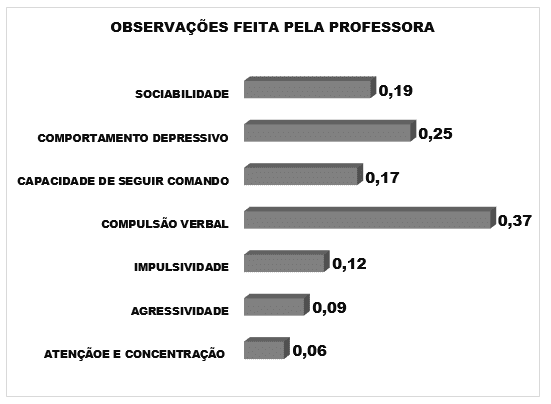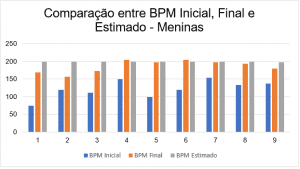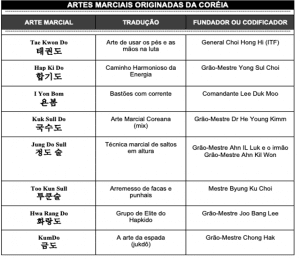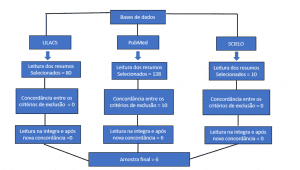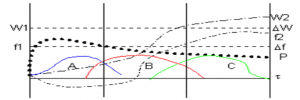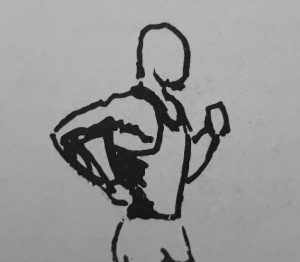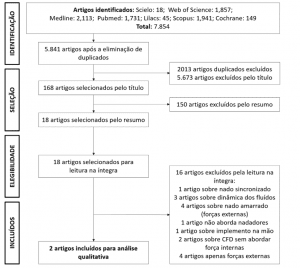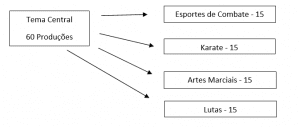ORIGINAL ARTICLE
FERREIRA, Maria Fernanda Lopes [1], NAGAMINE, Kazuo Kawano [2]
FERREIRA, Maria Fernanda Lopes. NAGAMINE, Kazuo Kawano. Behavioral assessment of preschool children in a swimming program. Revista Científica Multidisciplinar Núcleo do Conhecimento. Year 04, Ed. 10, Vol. 08, pp. 77-90. October 2019. ISSN: 2448-0959, Access Link: https://www.nucleodoconhecimento.com.br/education-physics-en/behavioral-assessment
ABSTRACT
Sports behavior is crucial during childhood and adolescence, as neurofunctional growth and development are accelerated. Evaluation of child behavior is important to identify difficulties and assist in behavioral diagnoses and interventions. The aim of this study was to evaluate the behavioral development of preschool children in a swimming program. Forty-five children between 3 and 5 years old enrolled in a swimming school in the city of São José do Rio Preto participated. The Child Behavior Check List CBCL / 1 and 5 years questionnaire was applied before and after the swimming program. For statistical analysis, the: Chi-square of McNemar, Prisma, and the Wilcoxon Test were used. A reduction in clinical cases and significant improvement in six syndromes after the program were found.
Keywords: Swimming, children, behavior, development.
1. INTRODUCTION
Borsa & Nunes (2011) indicate that there is a prevalence of 12.5% of mental disorders in the infant-juvenile population in Brazil and worldwide, and identify behavior problems as one of the most prevalent in children and adolescents, Borsa & Nunes (2011). In the Netherlands, approximately 10 to 25% of preschool children have problem behavior or emotional difficulties and only one in five children receives psychological care (THEUNISSEN, VOGELS, WOLFF, CRONE & REIJNEVELD, 2015).
In first-world countries, the adult population has children of later age, and pregnancy at advanced age is associated with increased mental illness and behavioral dysfunctions, with a higher risk, especially of depression, in children who have both very young and older parents (TEARNE, ROBISON, JACOBY, NEWNHAM & MCLEAN, 2015). Problem behaviors and emotional difficulties tend to start at preschool age and persist throughout development, causing harm in many areas of child functioning (PSYCHOGIOU, MOBERLY, PARRY, NATH, KALLITSOGLOU & RUSSELL, 2017). Problem behaviors are classified as internalizing (retract, depression, anxiety and somatic complaints) and externalizing (impulsivity, aggression, agitation, challenging and antisocial characteristics) (BOLSONI-SILVA, LOUREIRO & MATURANO, 2011).
The relationship between parents and children at the beginning of life is associated with a series of actions, through which the individual initiates and maintains stable affective relationships (ROHENKOHL & CASTRO, 2012). The relationship of parents is pointed out as an important factor for the quality of life of families, influencing the care of children and relationships between parents and children. The support of mothers is a determinant for the healthy development of children.
The evaluation and analysis of the behavior of children are important and necessary to identify the difficulties and enable resources to assist in behavioral diagnoses and subsequent interventions, either with the children themselves and/or with their parents/caregivers (BOLSONI-SILVA, et al., 2011).
The growing increase in mental health problems has motivated researchers around the world to study factors that provide protection or reduce vulnerability to the development of mental disorders. Moreover, there is a need to find methods that are more efficient than existing treatments, as well as adopt a preventive posture (BENKO, FARIAS & CORDEIRO, 2011).
Sports behavior has singular value during childhood and adolescence, when neurofunctional growth and development occur more rapidly and nutritional dysfunctions can impair the physical and mental functioning of these children. Thus, special attention to the monitored practice of physical exercises can be of vital importance to the proper development of neurobiological processes during this period, helping to combat obesity and its comorbidities, thus contributing to better physical and mental health of children (BENKO, et al., 2011).
The social and behavioral mechanisms, through which sports practice affects health, are identified in relation to the determinants of healthy behavior, sport can improve health due to positive influences on socialskills encouraged by teachers, instructors, leaders and also due to the disciplinary requirements of doing any group activity (JONES-PALM, & PALM, 2015). Sport favors personal resilience and self-esteem, promoting an opportunity to learn healthy social attitudes, can improve self-confidence, provide a sense of physical ability, and enable social recognition within school, at home and in society. (JONES-PALM, et al., 2015).
Among the sports that meet the goal of improving the development of children in early childhood, Professor Robyn Jorgens, from Griffith University in Australia (2012), says that swimming is the most appropriate sport, because it allows the practice of very young children, even before learning to walk, because 4-month-old babies can already start aquatic activities. Jorgens (2012) found that children under 5 years of age who have a swimming lesson were able to improve their cognition (intellectual development) and physical development, as well as their social skills and self-confidence, significantly more accelerated and consistently than children of the same age not practicing swimming (SELKE, 2014).
Jorgens (2012) found that children who start learning to swim at 4 or 5 years old have difficulties in learning the sport never faced by those children who started swimming as babies. In addition, the basic scores of the developmental requirements of children who swim since infants are significantly better than those who start swimming older.
Research documents that the stimulating effect of swimming programs for young children has the potential to increase intelligence, concentration, alertness and perception skills, as well as considerably improve social, emotional and physical development. They also give children a state of relaxation and calm that is very desirable and beneficial to learning (GRIFFITH UNIVERSITY, 2012; WEST, 2012).
2. JUSTIFICATION
Therefore, more generalized therapeutic alternatives aimed at improving quality of life are safer and beneficial for all patients with problem behavior and/or mental disorders. Thus, scheduled activities such as swimming classes, arts workshop, theater, athletics, among others, are more comprehensive and appropriate, mainly for children (KRIEGER, et al. 2013).
From a scientific point of view, the study of information on the development of children and collective child behaviors promotes the possibility of improving collective health, as well as the quality of public and private services provided to the child population.
Another relevant aspect of the research is that studies of prevalence in mental health at an early age (the first five years of life) are insufficient and scarce. Considering that neurobiological, economic, psychological and social evidence shows that interventions during the first years of life are highly efficient to reduce psychosocial problems, it is relevant to obtain national data on affective problems and conducts in early childhood and preschool age (LECANNELIER, EWERT, GROISSMAN, GALLARDO, BARDET, BASCUÑAN, & RODRÍGUEZ 2014).
3. OBJECTIVE
This study proposes to evaluate the behavior of children aged 3 to 5 years in a swimming program.
4. METHOD
4.1 PARTICIPANTS
Forty-five children from 3 to 5 years old regularly enrolled in a swimming school in São José do Rio Preto participated, 60% boys and 40% girls.
4.2 MATERIALS AND INSTRUMENTS
Inventory of behaviors of children between ½ – 5 years Child Behavior Checkilist (CBCL 1 ½ – 5) (ACHENBACH & RESCOLA, 2000), composed of 100 items that lead to two summarized scales: the scale of internalizing problems (emotional reactive, anxiety / depression, somatic complaint and isolation) and the scale of externalizing problems (attention problems and aggressive behavior). The inventory also presents syndromes guided by the Manual of Diagnosis and Statistics of Mental Disorders (DSM), which are: affective problems, anxiety problems, developmental problems, attention deficit and hyperactivity problems and challenging oppositional behavior problems. This inventory provides scores obtained from standardized assessment for children. CBCL has high test and retest reliability and high internal consistency. The reported validity of the criteria of both versions of the CBCL is supported by the ability of their quantitative scores to discriminate between demographically matched children, classified in clinical and non-clinical cases (CIMINO, CEMIGLIA, PORRECA, SIMONELLI, RONCONI & BALLAROTTO, 2016).
Sociodemographic questionnaire, created by the researcher herself to identify the profile of the participants, children and guardians. The instrument has eighteen questions, which are about age, sex, skin color, naturalness, time residing in the city, marital status of parents, education and occupational situation of parents, number of people living in the house, number of children, number of rooms in the house and family income.
Observations of the children’s behaviors made by the teacher, a table elaborated by the researcher to write down, daily, the behavioral issues of the children throughout the program. This instrument was conceived in order to provide data to enable a quantitative evaluation of individual behaviors. Each child had a diary, with notes of the specific behaviors presented in all classes. The items evaluated were: level of attention and concentration, aggressiveness, impulsivity, verbal compulsion, depressive behavior, ability to follow command and sociability; a scale from 0 to 3 was considered, with 0 representing less appropriate behavior and 3, a more appropriate behavior. The behavioral issues used were those suggested by authors of the literature researched in this study (BOLSONI-SILVA, et al., 2011; JONES-PALM, et al., 2015; & ROHENKOHL & CASTRO, 2012).
Swimming program, includes routines and sequences of activities compatible with the age group of the group. The activities were in and in the vicinity of a heated and covered swimming pool, a swimming school of São José do Rio preto. The exercises were systematic and varied, aiming to stimulate body awareness, such as balance, gallows, motor coordination, laterality, the notion of space, among others.
All the proposed activities are part of the didactic program and the teaching content of the school in question, whose objective is to develop, in children of this age group, regardless of the swimming experience, in addition to body awareness, the ability to travel in the water of 8 meters, both in the (survival swim), as in the rustic Crawl style, and of a displacement of , at least 5 meters in costas style.
The activities were timed with variable duration, respecting the physical and tolerance limit of each group. The sessions were held twice a week, lasting 30 minutes. The program was developed in six months.
4.3 PROCEDURES
The study was approved by the Research Ethics Committee of FAMERP (Faculty of Medicine of São José do Rio Preto/SP) – Opinion No. 1,420,285, on February 23, 2016.
The person in charge of each participant received a folder with the questionnaires to be completed in July 2016. He received the folder again in December 2016, only containing the CBCL questionnaire for a second completion. Thus, the CBCL was applied in two moments, before the swimming program and after six months, in order to compare the behaviors of the children
The data obtained by CBCL, were analyzed by descriptive analysis of the T score and frequency count, for the classification of clinical and non-clinical. Inferential statistics were also made using McNemar’s Chi-square test, using the statistical programs Statistical Package For Social Sciences (SPSS version 24.0) and prism (version 6.1, 2012). The data from the other questionnaires were analyzed by the Wilcoxon Test. A significance level of p ≤ 0.05 was adopted in all analyses.
5. RESULTS
Table 1 shows the comparison and percentage of clinical cases of each syndrome, for each gender, separately, for the total number of the sample and the P value, before and after the swimming program.
Table 1-comparison of clinical cases of each syndrome, pre and post swimming program
| Boys | Girls | TOTAL SAMPLE | |||||||
| PRE% | LATER% | P | PRE% | LATER% | P | PRE% | LATER% | P | |
| Emotional Reactive | 40,3 | 37,1 | 1 | 50 | 33,3 | 0,45 | 44,4 | 35,6 | 0,38 |
| Anxiety/Depression | 22,2 | 18,6 | 1 | 27,8 | 16,7 | 0,62 | 24,4 | 17,8 | 0,5 |
| Somatic Complaints | 29,7 | 25,9 | 1 | 50 | 44,4 | 1 | 37,8 | 33,3 | 0,79 |
| insulation | 37,1 | 25,9 | 0,45 | 50 | 33,3 | 0,45 | 42,2 | 28,9 | 0,18 |
| Problems with Sleep | 33,3 | 37,1 | 1 | 22,2 | 0 | 0 | 28,9 | 22,2 | 0,5 |
| Attention Problems | 11,1 | 11,1 | 1 | 5,6 | 0 | 0 | 8,9 | 6,7 | 1 |
| Aggressive Behavior | 37,1 | 29,7 | 0,5 | 33,3 | 5,6 | 0,63 | 35,6 | 20 | 0,01 |
| Internalization Scale | 44,4 | 37,1 | 0,68 | 66,7 | 44,4 | 0,12 | 53,3 | 40 | 0,1 |
| Outsourcing Scale | 44,4 | 37,1 | 0,21 | 61,1 | 44,4 | 0,04 | 51,1 | 40 | 0,18 |
| Total Problem Scale | 51,9 | 33,3 | 1 | 77,8 | 50 | 0,06 | 62, 2 | 40 | 0 |
| DSM-driven scales | |||||||||
| Affective Problems | 33,3 | 29,7 | 0,14 | 38,9 | 22,2 | 0,37 | 35,6 | 26,7 | 0,28 |
| Anxiety Problems | 51,9 | 59,2 | 0 | 50 | 38,9 | 0,72 | 51,1 | 51,1 | 1 |
| Developmental Problems | 22,2 | 22,2 | 0,68 | 61,1 | 22,2 | 0,03 | 37,8 | 22,2 | 0,09 |
| Attention Deficit And Hyperactivity Problems | 29,7 | 25,9 | 0,28 | 38,9 | 22,2 | 0,25 | 33,3 | 24,4 | 0,21 |
| Opposition and Challenge Issues | 40,8 | 25,9 | 0,12 | 38,9 | 16,7 | 0,21 | 40 | 22,2 | 0,02 |
In the statistical analysis, comparing all children with CBCL results, before and after the swimming program, three syndromes showed significant changes after the program. They are aggressive behavior, total problems, and challenging opositive behavior, in total children. However, when separated by gender, there was a significant difference in the improvement of boys, only in anxiety problems, in the syndrome guided by DSM, different from the result of the same syndrome, according to the CBCL inventory. Girls, on the other hand, had significant improvements in four syndromes: sleep problems, attention problems, externalizing problems and developmental problems. Therefore, it was observed that there was a significant improvement in the behavior of children in general and, observing by gender, girls showed a more significant improvement compared to boys.
In the descriptive analysis, when comparing the moments before and after the swimming lesson program, the children in the study showed a positive change in their behavior, there was a reduction in clinical cases in relation to the syndromes addressed by the scale, according to Table 2.
Table 2 Children who no longer had clinical scores in CBCL after the swimming program.
| THEY’RE NO LONGER A GP | Total | Boys | Girls | ||
| Emotional Reactive | 4 | 3 | 1 | ||
| Anxiety/Depression | 3 | 1 | 2 | ||
| Somatic Complaints | 2 | 1 | 1 | ||
| insulation | 6 | 3 | 3 | ||
| Problems with Sleep | 0 | +1 | 4 | ||
| Attention Problems | 1 | 0 | 1 | ||
| Aggressive Behavior | 7 | 2 | 5 | ||
| Internalizing Problems | 6 | 2 | 4 | ||
| Externalizing Problems | 5 | 2 | 3 | ||
| Total Problems | 10 | 5 | 5 | ||
| DSM-Oriented Scales | |||||
| Affective Problems | 4 | 1 | 3 | ||
| Anxiety Problems | 0 | +2 | 2 | ||
| Developmental Problems | 7 | 0 | 7 | ||
| Developmental Problems, | 4 | 1 | 3 | ||
| Opposition and Challenge Issues | 8 | 4 | 4 | ||
Note. + = increased number of clinicians
Analysis of observations of children’s behaviors made by the teacher/researcher throughout the program, Figure 1.
FIGURE 1 The values of the analysis made during the program for each behavior observed by the teacher.
In the comparison of the first class with the last one, there was no significant improvement in the behavior of children in general. On the other hand, in the researcher’s perception, in daily contact with the children, and also according to the report (feedback) of the parents and/or guardians, there was a significant improvement in the overall behavior of most children.
These improvements were observed in attitudes displayed during the classes, such as decreased anxiety, including a participant with medical diagnosis and medication prescription, improvement of attention, improvement of discipline, improvement of aggressiveness, improvement in the ability to follow command, with respect to colleagues, teacher and mothers/caregivers. It was also observed that a boy had worsening in his behavior, becoming more aggressive, stubborn, without enthusiasm for activities and even less for recreations, leaving class without warning. This worsening, according to the mother’s feedback, may have been due to external factors, such as the pregnancy of the mother of a third child, which would make the participant the middle child, in addition, the regular school teacher was also pregnant. Such facts may indicate that the boy felt more insecure and/or afraid of having less attention from parents/family members and also from the school teacher.
6. DISCUSSION
Forty-five children aged 3 to 5 years participated in the study, 27 of which were boys (60%) and 18 girls (40%), with predominance of white ethnicity, with 43 (95.6%) and 2 browns (4.4%), the 45 parents maintained a stable union during the study period. Regarding education and economic situation, parents had a cultural level from medium to high. Thus, the characteristics observed in the sample showed a homogeneous population, presenting the same socioeconomic level.
The behavioral assessment of preschool children contributed to identify important changes in the improvement of behavior after the swimming program. This evaluation detected a considerable improvement in the reduction of clinical cases after the program. In view of the scarcity of studies with children in this age group, there is a difficulty in finding a significant amount of similar results. Borsa, Souza & Bandeira (2011); Moura, Marinho-Casanova, Meurer & Campana (2008) also found it difficult to find significance in their results, pointing out externalizing problems as the most frequent, since Borsa, Souza & Bandeira (2011) themselves indicate that internalizing are the most most prevalent. Namely, in this study, in relation to externalizing problems, a smaller reduction in clinical cases was detected after the program, while, in relation to internalizing problems, a greater reduction in clinical cases was observed, and an even greater reduction was observed in relation to the total number of problems.
Still corroborating the phenomenon of subjectivity of the results of investigations of child behavior, some studies reveal that boys are the ones who present the most behavior problems, especially externalizing ones, while girls present fewer problems in general, and complaints regarding them related to internalizing behaviors (BORSA, SOUZA & BANDEIRA 2011; BORSA & NUNES 2011). These findings differ from the results of this study, because it was observed that among boys internalizing problems were more frequent, while the externalizing of girls were more significant, this difference may be related to the idiosyncrasies of the subjects in the sample, in addition to the factors associated with gender difference, such as hormonal characteristics, cultural preserves and expectations in relation to gender roles (BORSA & COLS., 2011; BORSA E NUNES, 2011).
Authors also identify that, regardless of culture and geographic space, child development is marked by behavioral transformations considered important, because they allow the child to learn new skills, and because they characterize child behaviors as desirable or undesirable (BOLSONI-SILVA, MARTURANO, & MANFRINATO, 2005).
Desirable or appropriate behaviors are those resulting from changes that occur as a consequence of the interaction of the organism with the environment, allowing the child to contact with important learning situations that promote development. Undesirable behaviors, in turn, refer to the problems of attitudes arising from excess or lack of situations, and environments that would facilitate and expand the possibilities of learning and, consequently, development. Undesirable behaviors manifest themselves in internalizing or externalizing problems (ACHENBACH, 1991; BOLSONI- SILVA et al., 2005). Regarding this item, during the program proposed here, the children showed gradual and considerable improvement in desirable behaviors according to (BOLSONI-SILVA, MARTURANO, & MANFRINATO, 2005).
In view of the wide range of variables, it is clear the determination of multiple behavioral problems and, even though, for example, negative parent practices predictive of behavioral problems, these are not the exclusive indicator variables, although they are very important and clearly documented (BOLSONI-SILVA, LOUREIRO & MATURANO, 2011).
Theunissen, et al. (2015) also postulate that children with psychological problems are prone to experience difficulties in various aspects of their daily functioning. These problems can be severe and persist for a long time. However, considering that one of the exclusion criteria of this study was a diagnosis of mental illness, the children participating in this study did not present specific difficulties in any aspect of their behavior in the program.
7. CONCLUSION
It was concluded that the swimming program favored the reduction of clinical cases and in the behavior of children aged 3 to 5 years. Although the results are an important contribution to the theoretical models of behavioral evaluation, it is important to consider the limitations of the study that are related to the sample bias, and this study was defined by convenience, not meeting the rigors of randomness. Another limitation that needs to be considered is the fact that there was no control group, however, not being able to attribute behavioral improvement entirely to the swimming program. In addition, the reduced sample size and the children’s natural development and evolution and the researcher’s direct contact with the participants may have made it difficult to clarify the results.
Nevertheless, there was an improvement in the behavior of children after the swimming program, observing a considerable improvement, by descriptive analysis, in comparison with statistical analysis in the following syndromes: aggressive behavior, total problems, challenging opositive behavior, problems with sleep, attention problems, externalizing problems and developmental problems. According to the quantitative statistical analysis, comparing the first class with the last, there was no significant improvement in the behavior of children in general. On the other hand, in the researcher’s perception, in daily contact with the children, and also according to the report (feedback) of the parents and/or guardians, there was an improvement in the general behavior of most children.
REFERENCES
ACHENBACH, T. M. Manual for the Child Behavior Checklist/4-18 and 1991 profile. 1991. Burlington: Departament of Psychiatry, University of Vermont.
ACHENBACH, T. M.; & RESCORLA, L. A. Manual for the ASEBA preschool forms & profiles. 2000. Burlington, 05401-3456. Web: www.ASEBA.org.
BENKO, C. R., FARIAS, A. C. & CORDEIRO, M. L. Eating habits and psychopathology: translation, adaptation, reliability of the nutrition behavior inventory to Portuguese and relation to psychopathology. J Bras Psiquiatr, 2011. 240-6
BOLSONI-SILVA, A. T., MARTURANO, E. M. & MANFRINATO, J. W. D. Mães avaliam comportamentos socialmente desejados e indesejados de pré-escolares. Psicologia em estudo, Maringá, 10, 2005. 245-252.
BOLSONI-SILVA, A. T., LOUREIRO, S. R. & MARTURANO, E. D. Problemas de comportamento e habilidades sociais infantis: modalidades de relatos. 42(3), 2011. 354-361.
BORSA, J. C, & NUNES, M. L. T. Prevalência de problemas de comportamento em uma amostra de crianças em idade escolar da cidade de Porto Alegre. Aletheia, 20011. 34 Canoas abr.
BORSA, J. C., SOUZA, D. S. & BANDEIRA, D. R. Prevalência dos problemas de comportamento de uma amostra de crianças do Rio Grande do Sul. Psicologia: Teoria e Prática. 13(2):65-29, 2011.
CIMINO, S., CERNIGLIA, L., PORRECA, A. SIMONELLI, A., RONCONI, L. & BALLAROTTO, G. Mothers and Fathers with Binge Eating Disorder and Their 18–36 Months Old Children: A Longitudinal Study on Parent–Infant Interactions and Offspring’s Emotional–Behavioral Profiles. Front. Psychol. 7:580, 2016
GRIFFITH UNIVERSITY. “children who swim start smarter, study suggests.” ScienceDaily, disponívem em: www.sciencedaily.com/releases/2012/11/121116124603.htm. Acessado em: 16/09/2015
JONES-PALM, D. H. & Palm, J. Physical activity and its impact on health behavior among youth. Disponível em: https://www.icsspe.org/sites/default/files/PhysicalActivity.pdf. Acessado em: 12/07/2015
KRIEGER, F. V., LEIBENLUFT, STRINGARIS, A. & POLANCZYK, G. V. Irritability in Children and Adolescents: past concepts, current debates, and future opportunities. Rev. Bras. Psiquiatr. São Paulo: 35 (1), 2013,
LACANNELIER, F., EWERT, J. C. P., GROISSMAN, S., GALLARDO, D.; BARDET, A. M., Bascuñan, A. Validation of child inventory for children ages 1 to 5 years (cbcl 1 – 5) at the Santiago de Chile city. Univ. Psychol. 13 (2) bogotá apr/june, 2014.
MOURA, C. B., MARINHO-CASANOVA, M. L., MEURER, P. H., & CAMPANA, C. Caracterização da clientela pré-escolar de uma clínica-escola brasileira a partir do Child Behavior Checklist (CBCL). Contextos Clínicos, 1. (1), 1-8. 2008
PSYCHOGIOU, L.; MOBERLY, N. J.; PARRY, E,; NATH, S.; KALLITSOGLOU, A. & RUSSELL, G. Parental depressive symptoms, children’s emotional and behavioural problems, and parents’ expressed emotion—Critical and positive comments. PLoS ONE 12(10) 0183546. 2017
ROHENKOHL, L. M. I. A., CASTRO, E. K. Afetividade, conflito familiar e problemas de comportamento em pré-escolares de famílias de baixa renda: visão de mães e professoras. Psicol. Cienc. Prof. 32 (2) Brasília.2012
SELKE, L. A. Can Newborn Babies Swim? Livestrong.com. Disponível em http://www.livrestrong.com/article/237480-can-newborn-babies-swim/ Acessado em 13/03/2014
THEUNISSEN, M. H. C., VOGELS, A. G. C., WOLFF, M. S., CRONE, M. R. & REIJNEVELD, S. A. Comparing three short questionnaires to detect psychosocial problems among 3 to 4-year olds. BMC Pediatrics, Disonível em: at:http://www.biomedcentral.com/1471-2431/15/84. Acessado em: 24/03/2015
WEST, W. Do early Swimming Lessons Give Kids the Best Start? Family Edge Human Dignity & the Family. 30 november 2012.
[1] PhD in progress in Molecular Biophysics; Master’s degree in Psychology and Health; Graduation in Physical Education.
[2] PhD in Health Sciences, Improvement in Physiotherapy. Graduation in Physical Education.
Submitted: May, 2019.
Approved: October, 2019.
